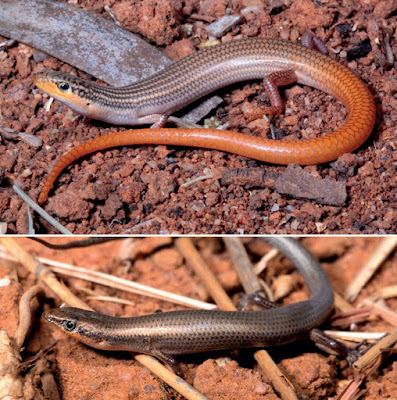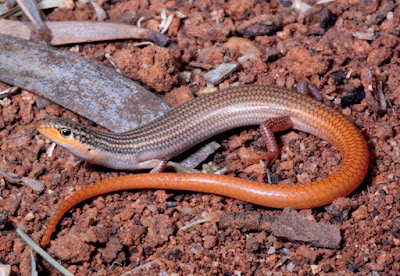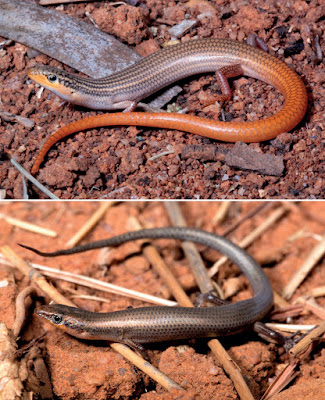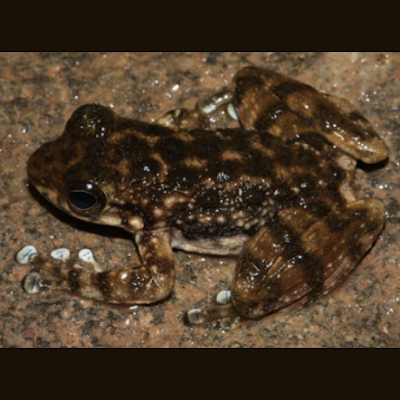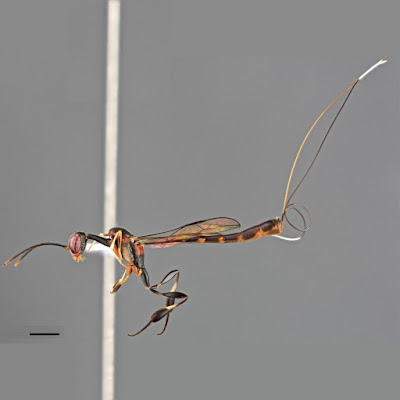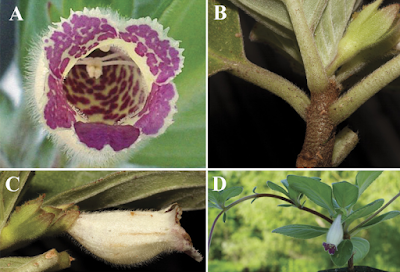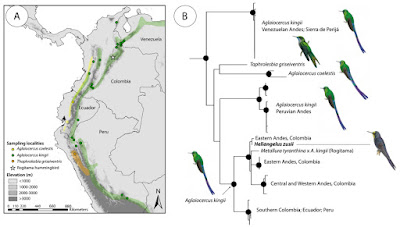[Most Recent Entries] [Calendar View]
Tuesday, May 15th, 2018
| Time | Event | ||||
| 2:01a | [Herpetology • 2018] Austroablepharus gen. nov. • A New Genus to Accommodate Three Skinks Currently Assigned to Proablepharus (Lacertilia: Scincidae)
ABSTRACT The genus Proablepharus currently contains five species (P. barrylyoni, P. kinghorni, P. naranjicaudus, P. reginae and P. tenuis). Morphologically, these are readily separated into two groups: the small, almost patternless species (P. reginae and P. tenuis) and the larger, striped species (P. kinghorni, P. barrylyoni and P. naranjicaudus). We present genetic and morphological data to demonstrate that these two groups are generically distinct from each other. As P. reginae is the type species for Proablepharus, we erect a new genus, Austroablepharus gen. nov., for the kinghorni group and designate A. kinghorni as the type species. Keywords: Proablepharus, Austroablepharus gen. nov., Australia, morphology, genetics.
Proablepharus Fuhn, 1969 Proablepharus reginae (Glauert, 1960) Proablepharus tenuis (Broom, 1896) Austroablepharus gen. nov. Suggested common name. Grassland Striped Skinks. Type species. Austroablepharus kinghorni (Copeland, 1947) Species. A. kinghorni (Copland 1947), A. naranjicaudus (Greer, Fisher & Horner 2004), A. barrylyoni (Couper, Limpus, McDonald & Amey 2010). Etymology. Austro for Australia and ablepharus referring to an immovable lower eyelid that is partially fused to the upper eyelid to form a permanent spectacle. Diagnosis. A genus of small skinks (adult SVL ≤ 51mm ) with pentadactyl limbs, ≤ 24 midbody scale rows, ≥ 55 paravertebral scales, and ≥ 30 presacral vertebrae. Limbs narrowly to widely separated when adpressed. Supranasals absent and nasals undivided; prefrontals large, in contact or narrowly separated; eye moderate-sized with lower eyelid immovable, partially fused to upper eyelid to form a permanent spectacle but with a distinct slit between the lower eyelid and the supraciliaries (preablepharine); frontoparietals fused; interparietal free or fused; ear opening very small; parietals in contact; body pattern consisting of alternating pale and dark stripes (each dorsal body scale with a pale centre and dark lateral edges); adult tail colouration red/orange. Patrick J. Couper, Conrad J. Hoskin, Sally Potter, Jason G. Braggand Craig Moritz. 2018. A New Genus to Accommodate Three Skinks Currently Assigned to Proablepharus (Lacertilia: Scincidae). Memoirs of the Queensland Museum – Nature. 60; 227-231. DOI: 10.1082/j.2204-1478.60.2017.2017-15 | ||||
| 2:02a | [Herpetology • 2018] Amolops yunkaiensis • A New Species of Amolops (Anura: Ranidae) from southwestern Guangdong, China
Abstract A new species, Amolops yunkaiensis sp. nov. is described based on a series of specimens from Ehuangzhang Nature Reserve and Yunkaishan Nature Reserve, southwestern Guangdong Province, China. The new species can be distinguished from all known congeners by molecular divergence in the mitochondrial 16S rRNA, 12S rRNA and CO1 genes, and a combination of the following characters: relatively small body size, SVL 31.8–34.1 mm in adult males, 35.2–39.0 mm in adult females; numerous raised large warts on dorsum and flanks; dorsal body olive-brown or light brown with dark brown blotches; absence of vomerine teeth; absence of tarsal glands; presence of a pair of subgular vocal sacs, nuptial spines on the first finger, and sparse translucent tubercles on the lower jaw, forechest, posterior belly and ventral thigh in male. Hence, the genus Amolops contains 52 species, 29 of which occur in China. Keywords: Amolops torrentis, Amolops yunkaiensis sp. nov., mitochondrial DNA, morphology, Amphibia Amolops yunkaiensis Lyu, Wang, Liu, Zeng and Wang, sp. nov. Amolops torrentis (Smith, 1923): Fei et al. 2009 (Xinyi, Guangdong). Amolops torrentis: Wei et al. 2010 (Yunkaishan Nature Reserve, Xinyi, Guangdong). .... Etymology. The specific name, yunkaiensis, refers to the locality of the new species, the Yunkai Mountains. We suggest its English common name “Yunkai Torrent Frog” and Chinese name “Yun Kai Tuan Wa”. Zhi-Tong Lyu, Jun Wu, Jian Wang, Yik-Hei Sung, Zu-Yao Liu, Zhao-Chi Zeng, Xin Wang, You-Yu Li and Ying-Yong Wang. 2018. A New Species of Amolops (Anura: Ranidae) from southwestern Guangdong, China. Zootaxa. 4418(6); 562–576. DOI: 10.11646/zootaxa.4418.6.4 | ||||
| 2:48a | [Entomology • 2018] Gasteruption tomanivi • First Record of Gasteruption Latreille (Hymenoptera: Evanioidea: Gasteruptiidae) from Fiji with the Description of A New Species
Abstract A new Gasteruption Latreille species, Gasteruption tomanivi, is described from Viti Levu, Fiji. The new species is the first record of the genus for Fiji and can be distinguished from other Oceanian Gasteruption species by the length of the mesosoma and the large malar space compared with the length of the pedicel. DNA Barcode (mtDNA—COI) sequence is provided. Keywords: Hymenoptera, taxonomy, Viti Levu, Mt Tomanivi, Gasteruption tomanivi, DNA barcode
Ben A. Parslow, Mark I. Stevens and Michael P. Schwarz. 2018. First Record of Gasteruption Latreille (Hymenoptera: Evanioidea: Gasteruptiidae) from Fiji with the Description of A New Species. Zootaxa. 4407(1); 111–116. DOI: 10.11646/zootaxa.4407.1.7 Nature’s secrets abound in Fiji highlands http://indai.ly/267424 via @indaily Extraordinary levels of hidden biodiversity discovered in Fiji https://nexusnewsfeed.com/article/climat | ||||
| 3:51a | [Botany • 2018] Alsobia baroniae (Gesneriaceae) • A New Species of Alsobia from Belize, with a Synopsis of the Genus
Abstract Alsobia baroniae L. E. Skog & Barrie, a new species of Alsobia Hanst. (Gesneriaceae: Episcieae), is described from the karst region of central Belize. The new species is endemic to Belize, known from but a few collections, and is distinguished from the other three known species of Alsobia mainly by its larger leaves, 10–26 cm long, and its densely pilose corolla. The genus is now expanded to four species. A synopsis of the genus is given, including descriptions of the genus and known species and a key to species. Keywords: Alsobia, Belize, Gesneriaceae, karst Alsobia baroniae L. E. Skog & Barrie .... Etymology. Alsobia baroniae is named in honor of Ms. Ella Baron, founder and director of Ian Anderson’s Caves Branch Botanical Garden, Belmopan, Belize. Ms. Baron and her husband, Mr. Anderson, have collaborated with the Marie Selby Botanical Gardens in expeditions that have greatly expanded our knowledge of the epiphytic flora of Belize. As a consequence, the number of epiphytic species recorded has increased from ca. 400 in 2000, the year the Belize checklist was published (Balick et al., 2000), to some 650 today. Fred R. Barrie, Laurence E. Skog and John L. Clark. 2018. A New Species of Alsobia (Gesneriaceae) from Belize, with a Synopsis of the Genus. Novon: A Journal for Botanical Nomenclature. 26(1); 1-8. DOI: 10.3417/2017043 | ||||
| 8:11a | [Ornithology • 2017] Heliangelus zusii • An Extinct Hummingbird Species That Never Was: A Cautionary Tale About Sampling Issues in Molecular Phylogenetics Abstract The Bogota Sunangel (Heliangelus zusii) was described based on a historical specimen lacking locality data as a striking - and potentially extinct - new species of hummingbird more than two decades ago. However, it was considered a dubious taxon by some researchers until a molecular study with strong species-level taxon sampling revealed its phylogenetic affinities and validated its status as a distinct species. We reanalysed existing mitochondrial DNA data together with a new data set sampling multiple populations of the Long-tailed Sylph (Aglaiocercus kingii), a species broadly distributed in the Andes of South America. In contrast to previous work, we found that H. zusii shares a haplotype with specimens of A. kingii from the Eastern Cordillera of Colombia, which is phylogenetically nested within a clade formed by populations of A. kingii from the Colombian Andes. These results suggest that H. zusii is not a distinct species, but is most likely the result of hybridization between a female A. kingii and a male of another hummingbird species. These findings highlight the importance of thorough taxonomic and geographic sampling when assessing the likelihood of hybrid origin of an organism, particularly in cases potentially involving wide-ranging species in areas where deep phylogeographic structure is likely. Keywords: Aglaiocercus, geographic sampling, Heliangelus zusii, hybridization, phylogeography. Jorge L. Perez-Eman, Jhoniel Perdigon Ferreira, Natalia Gutierrez-Pinto, Andres M. Cuervo, Laura N. Cespedes, Christopher C. Witt and Carlos Daniel Cadena. 2017. An Extinct Hummingbird Species That Never Was: A Cautionary Tale About Sampling Issues in Molecular Phylogenetics. bioRxiv. DOI: 10.1101/149898 |
| << Previous Day |
2018/05/15 [Calendar] |
Next Day >> |
